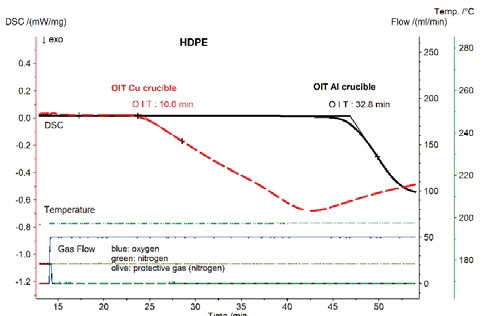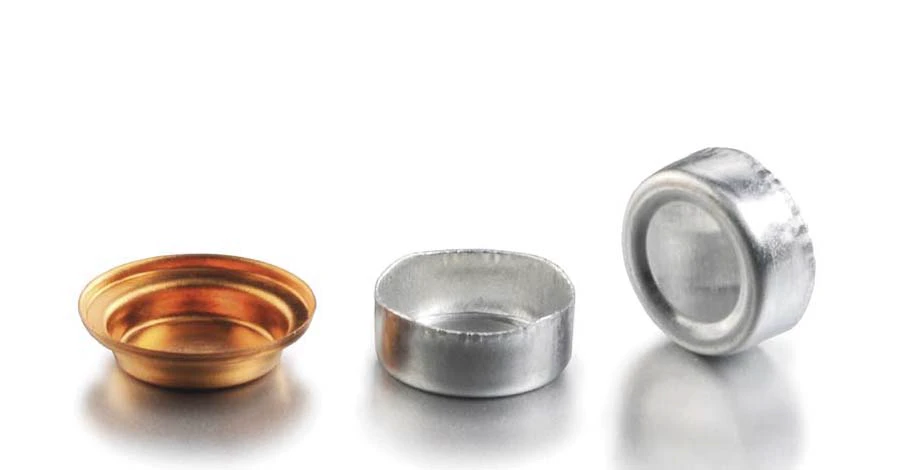Oxidative-Induction Time (OIT)
Oxidative-induction time (Oxidative-Induction Time (OIT) and Oxidative-Onset Temperature (OOT)Oxidative Induction Time (isothermal OIT) is a relative measure of the resistance of a (stabilized) material to oxidative decomposition. Oxidative-Induction Temperature (dynamic OIT) or Oxidative-Onset Temperature (OOT) is a relative measure of the resistance of a (stabilized) material to oxidative decomposition.OIT) measurements allow for characterization of the long-term stability of hydrocarbons such as oils, fats, but also of plastics like polyolefins, particularly polypropylene and polyethylene.
For determination of the oxidative stability, standardized test methods by means of DSC (Differential Scanning Calorimetry) are used. These tests can easily be carried out and provide reliable information on the stability of e.g., a polyethylene coating. The thermo-oxidative performance of a material can be predicted and failure prevention can be achieved.
Oxidative-Induction Time (OIT) and Oxidative-Onset Temperature (OOT)Oxidative Induction Time (isothermal OIT) is a relative measure of the resistance of a (stabilized) material to oxidative decomposition. Oxidative-Induction Temperature (dynamic OIT) or Oxidative-Onset Temperature (OOT) is a relative measure of the resistance of a (stabilized) material to oxidative decomposition.OIT tests by means of DSC are internationally recognized. Well-established standards are e.g., ASTM D3895-92, ASTM D6186, EN 728 und ISO 11357-6.
DSC systems for determination of the Oxidative-Induction Time (OIT) and Oxidative-Onset Temperature (OOT)Oxidative Induction Time (isothermal OIT) is a relative measure of the resistance of a (stabilized) material to oxidative decomposition. Oxidative-Induction Temperature (dynamic OIT) or Oxidative-Onset Temperature (OOT) is a relative measure of the resistance of a (stabilized) material to oxidative decomposition.OIT are the DSC 204 F1 Phoenix®, DSC 200 F3 Maia and DSC 404 F1 /F3 Pegasus®.
Method
The samples are heated under a protective gas to a temperature above their Melting Temperatures and EnthalpiesThe enthalpy of fusion of a substance, also known as latent heat, is a measure of the energy input, typically heat, which is necessary to convert a substance from solid to liquid state. The melting point of a substance is the temperature at which it changes state from solid (crystalline) to liquid (isotropic melt).melting point. At a constant temperature, the sample atmosphere is switched from inert to oxidative. The amount of time elapsing until the ExothermicA sample transition or a reaction is exothermic if heat is generated.exothermalOxidationOxidation can describe different processes in the context of thermal analysis.oxidation of the sample begins is referred to as Oxidative-Induction Time (OIT) and Oxidative-Onset Temperature (OOT)Oxidative Induction Time (isothermal OIT) is a relative measure of the resistance of a (stabilized) material to oxidative decomposition. Oxidative-Induction Temperature (dynamic OIT) or Oxidative-Onset Temperature (OOT) is a relative measure of the resistance of a (stabilized) material to oxidative decomposition.OIT.

OIT Measurement Conditions for all Examples Presented
- Crucible material: aluminum, open
- Atmosphere: O2 / N2
- Purge gas rate: 50 ml/min
- IsothermalTests at controlled and constant temperature are called isothermal.Isothermal temperature: 210°C, 190°C
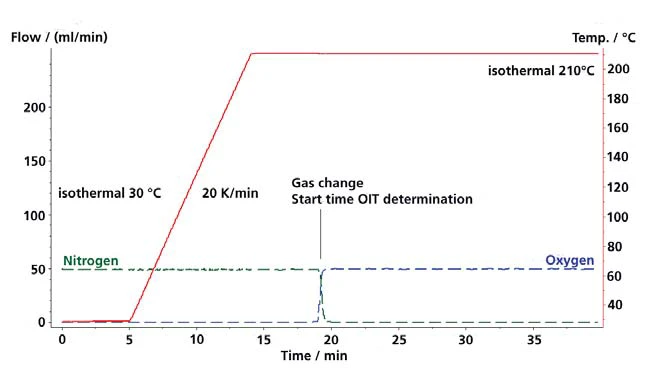
OIT Tests on PE-HD Samples Differing in Grade
Only very small differences were determined for the melting behavior (melting enthalpy and peak temperature) of two PE-HD samples differing in grade (figure 2a). However, clear differences between the two samples can be observed in the Oxidative-Induction Time (OIT) and Oxidative-Onset Temperature (OOT)Oxidative Induction Time (isothermal OIT) is a relative measure of the resistance of a (stabilized) material to oxidative decomposition. Oxidative-Induction Temperature (dynamic OIT) or Oxidative-Onset Temperature (OOT) is a relative measure of the resistance of a (stabilized) material to oxidative decomposition.OIT. Sample Grade 1 is stable 43 min before OxidationOxidation can describe different processes in the context of thermal analysis.oxidation starts (figure 2b). Sample Grade 2 yields a much lower stability; the Oxidative-Induction Time (OIT) and Oxidative-Onset Temperature (OOT)Oxidative Induction Time (isothermal OIT) is a relative measure of the resistance of a (stabilized) material to oxidative decomposition. Oxidative-Induction Temperature (dynamic OIT) or Oxidative-Onset Temperature (OOT) is a relative measure of the resistance of a (stabilized) material to oxidative decomposition.OIT is reached after 23 min.
This example already shows that more detailed information can be obtained from DSC curves just by varying the temperature program.

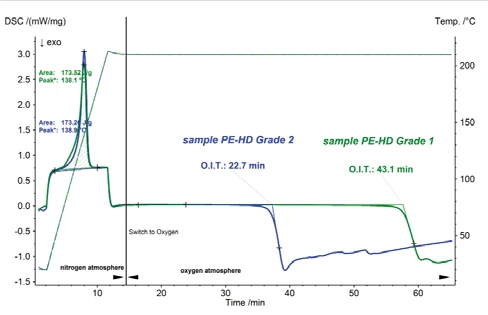
PP T20 from Different Producers
Two highly heat-resistant polypropylene samples from different producers were investigated regarding their oxidative stability. Again, the melting behavior of the two materials is nearly identical. Only the Oxidative-Induction Time (OIT) and Oxidative-Onset Temperature (OOT)Oxidative Induction Time (isothermal OIT) is a relative measure of the resistance of a (stabilized) material to oxidative decomposition. Oxidative-Induction Temperature (dynamic OIT) or Oxidative-Onset Temperature (OOT) is a relative measure of the resistance of a (stabilized) material to oxidative decomposition.OIT tests reveal the difference. The oxidative stability of sample “Producer A” is determined at 15 min whereas the second sample “Producer B” shows a very high stability. Here, degradation starts after 122 min (figure 3).
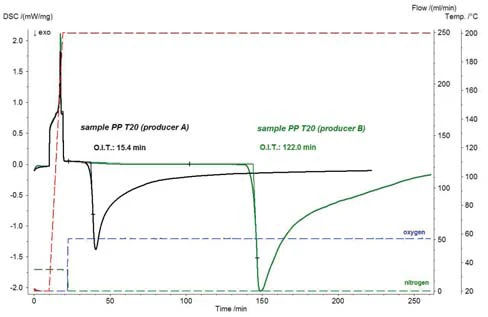
Results of OIT Tests on PE Granulate, Extruded Tube and Aged Tube
Materials PE-HD, PE-RT Type 1 and PE-RT Type 2 were investigated, each as a granulate, an extruded tube and an aged tube. All were subjected to a temperature change treatment. The melting behavior and behavior in an oxidizing atmosphere for sample series PE-HD and PE-RT Type 1 are depicted in figures 4a, 4b and 5a, 5b.
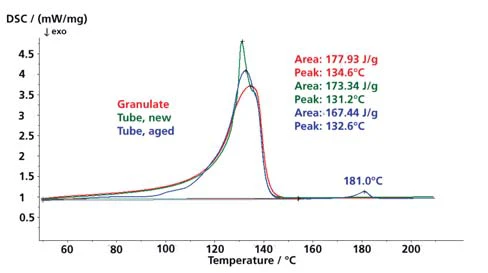
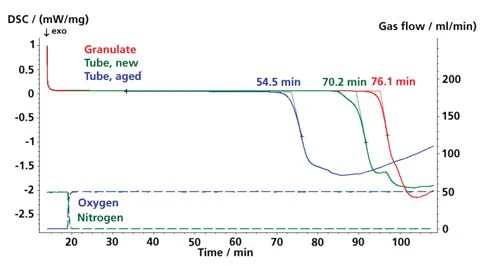
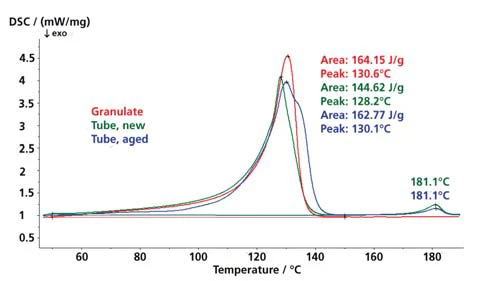
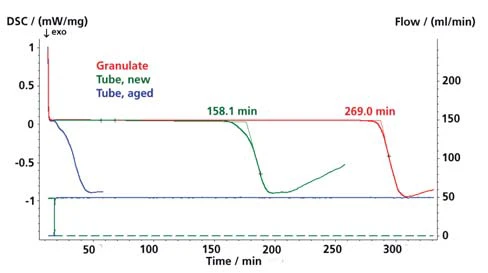
In addition, figure 5b demonstrates that occasionally, the Oxidative-Induction Time (OIT) and Oxidative-Onset Temperature (OOT)Oxidative Induction Time (isothermal OIT) is a relative measure of the resistance of a (stabilized) material to oxidative decomposition. Oxidative-Induction Temperature (dynamic OIT) or Oxidative-Onset Temperature (OOT) is a relative measure of the resistance of a (stabilized) material to oxidative decomposition.OIT cannot be evaluated due to a very low oxidative stability. When the atmosphere is switched from nitrogen to oxygen, the aged material (blue curve) starts to degrade with an insignifi cant time delay. In cases like these, a dynamic temperature program is helpful to show the differences of apparently same materials.
Dynamic Temperature Program for the Determination of the Oxidative Stability of PE Granulate, Extruded Tube and Aged Tube
If the samples to be compared are very different regarding their resistance to oxygen, it will not be possible to present a comparison at an identical IsothermalTests at controlled and constant temperature are called isothermal.isothermal temperature. Figure 6 shows an alternative temperature program ensuring that the samples are entirely molten and enabling a change of atmosphere at a temperature at which the most reactive sample does not react immediately after the gas change (see figure 6).
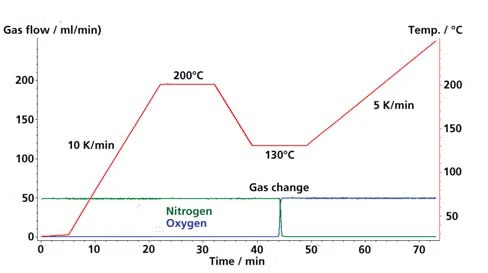
The melting behavior and OxidationOxidation can describe different processes in the context of thermal analysis.oxidation behavior of sample series PE-RT Type 2 are presented in figures 7a and 7b. The IsothermalTests at controlled and constant temperature are called isothermal.isothermal temperature cannot be selected lower than 180°C since one component melts at approximately 180°C. One can now significantly distinguish between strongly differing OxidationOxidation can describe different processes in the context of thermal analysis.oxidation behaviors by using a dynamic temperature program


Failure Analysis of TPE Parts Via Dynamic OIT, the So-called OOT (Oxidative Onset Temperature)
In ASTM E2009-08, the oxidative onset temperature is described as a relative measure of the degree of oxidative stability of the material evaluated at a given heating rate and oxidative environment, for example, oxygen; the higher the Oxidative-Induction Time (OIT) and Oxidative-Onset Temperature (OOT)Oxidative Induction Time (isothermal OIT) is a relative measure of the resistance of a (stabilized) material to oxidative decomposition. Oxidative-Induction Temperature (dynamic OIT) or Oxidative-Onset Temperature (OOT) is a relative measure of the resistance of a (stabilized) material to oxidative decomposition.OOT value, the more stable is the material.
The Oxidative-Induction Time (OIT) and Oxidative-Onset Temperature (OOT)Oxidative Induction Time (isothermal OIT) is a relative measure of the resistance of a (stabilized) material to oxidative decomposition. Oxidative-Induction Temperature (dynamic OIT) or Oxidative-Onset Temperature (OOT) is a relative measure of the resistance of a (stabilized) material to oxidative decomposition.OOT can be used for comparative purposes; it is not an absolute measurement technique like the Oxidative-Induction Time (OIT) and Oxidative-Onset Temperature (OOT)Oxidative Induction Time (isothermal OIT) is a relative measure of the resistance of a (stabilized) material to oxidative decomposition. Oxidative-Induction Temperature (dynamic OIT) or Oxidative-Onset Temperature (OOT) is a relative measure of the resistance of a (stabilized) material to oxidative decomposition.oxidative-induction time (OIT) at a constant temperature (ASTM E1858). The presence or effectiveness of antioxidants may be determined by this test method.
DSC measurements were carried out on two TPE parts (poor and good) with a sample mass of approx. 14 mg. For the measurements, closed aluminum crucibles with pierced lid and an N2 atmosphere were chosen. The heating rate amounted to 10 K/min (figure 8). At 210°C, the atmosphere was switched to oxygen and the heating rate was lowered to 5 K/min (figure 9).
During the 1st heating, the good (blue curve) and poor sample (green curve) show the same thermal behavior. The Glass Transition TemperatureThe glass transition is one of the most important properties of amorphous and semi-crystalline materials, e.g., inorganic glasses, amorphous metals, polymers, pharmaceuticals and food ingredients, etc., and describes the temperature region where the mechanical properties of the materials change from hard and brittle to more soft, deformable or rubbery.glass transition and peak temperatures, but also the melting enthalpy are almost identical (figure 8). However, after changing the atmosphere but still increasing the temperature, the DSC curves demonstrate differences which can be seen in a deviating OxidationOxidation can describe different processes in the context of thermal analysis.oxidation behavior of the two samples (figure 9). The oxidative onset temperature (Oxidative-Induction Time (OIT) and Oxidative-Onset Temperature (OOT)Oxidative Induction Time (isothermal OIT) is a relative measure of the resistance of a (stabilized) material to oxidative decomposition. Oxidative-Induction Temperature (dynamic OIT) or Oxidative-Onset Temperature (OOT) is a relative measure of the resistance of a (stabilized) material to oxidative decomposition.OOT) of the poor sample (green curve) is determined to 229°C whereas that of the good part only occurs above 241°C.
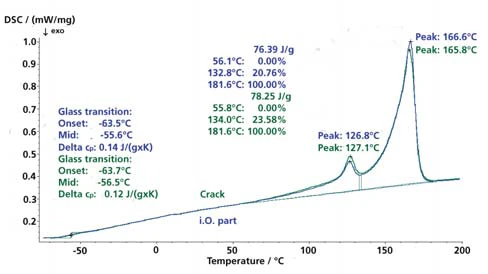

Influence of Crucibles on the Oxidative-Induction Time
The Oxidative-Induction Time (OIT) and Oxidative-Onset Temperature (OOT)Oxidative Induction Time (isothermal OIT) is a relative measure of the resistance of a (stabilized) material to oxidative decomposition. Oxidative-Induction Temperature (dynamic OIT) or Oxidative-Onset Temperature (OOT) is a relative measure of the resistance of a (stabilized) material to oxidative decomposition.oxidative-induction time (OIT) can be determined in standard aluminum or open copper crucibles in accordance with ASTM D3895.
This plot represents an OIT measurement on HDPE carried out in an open copper (red) and Al (black) crucible, respectively (figure 10). It can clearly be seen that under IsothermalTests at controlled and constant temperature are called isothermal.isothermal conditions, OxidationOxidation can describe different processes in the context of thermal analysis.oxidation of HDPE begins approximately 23 min earlier in the copper crucible than in the Al crucible.
Besides copper crucibles, aluminum crucibles the bottom of which can be shaped with the stamping tool kit of the sealing press are available (figure 11). These crucibles are especially designed for determination of the OIT of lubricants and grease in accordance with ASTM D5483-5.
